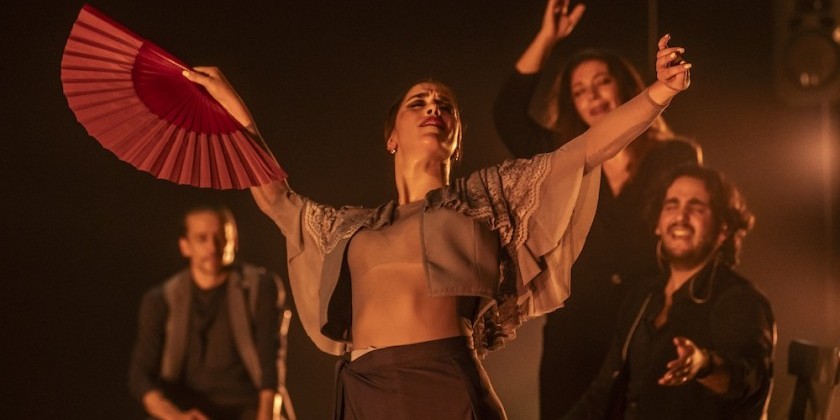The Once and Future Star: Farruquito Returns in "Improvisao"

As he opens the New York Flamenco Festival
Where: New York City Center, 55th Street between Sixth and Seventh Avenues
When: 8 p.m. March 10-11
Tickets: $35- $125; call (212) 581-1212 or visit nycitycenter.org
The Spanish dancer known as Farruquito is a daredevil. Though he speaks softly and he looks relaxed, settling comfortably into a sofa for our interview, this slender, unpretentious man specializes in tight-rope style performing.
His show, which opens the New York Flamenco Festival on Thursday, is called Improvisao; and as the title says, Farruquito improvises all his dances on the spot. If he slips, no safety net hangs waiting to catch him. Dancing without a script is the biggest risk he can take, and far more dangerous a stunt than simply hurtling through the air.
Yet Farruquito doesn’t count on luck to get him through the show alive. “I don’t have any good-luck charms,” he says smiling. “What’s most important is concentration, and love for your profession.”
Instead of counting on luck, Farruquito has what he calls “resources.” He doesn’t mean technique, although he has plenty of that, too. His resources are the knowledge he accumulated growing up surrounded by the finest music and dancing. Juan Manuel Fernández Montoya, as he was born in 1982, is the scion of a family of Spanish artists. He took lessons from his grandfather, the legendary dancer “El Farruco;” and he first set foot on a Broadway stage when he was a child accompanying an extended clan that included his father, the singer known as “El Moreno;” his mother, “La Farruca;” and his aunt, “La Faraona.” That was in the 1986 show Flamenco Puro.

Director Carlos Saura recorded Farruquito’s dancing in the documentary Flamenco in 1995, including the promising youngster among the greatest stars of that era. Farruquito created his own first show, Raíces Flamencas, when he was only 15, touring it internationally. When the skinny teenager returned to New York with his family in 2001, ready to make his mark in the world’s dance capital, his performance at Town Hall caused a sensation. He was back in 2003, looking more polished than ever and sharing the stage with flamenco powerhouse Juana Amaya under the auspices of the New York Flamenco Festival. Then tragedy struck. That year he drove through a red light killing a pedestrian. Farruquito spent 14 months in jail; and his phenomenal career abruptly derailed. His American fans have been waiting for his return ever since.
While putting his skills to the test, Farruquito says that Improvisao will also give him the chance to do what he does best. He loves music —especially the raw-voiced singing of the cantaor, which his father taught him to appreciate — and he takes inspiration from it. He feeds off the atmosphere created by a particular rhythm, and gives himself the freedom to evolve inside it. Although he and his colleagues practice together and occasionally he hits upon a combination of steps that seems to work well, he adds, “I don’t change my way of dancing according to what works. I keep changing my way of dancing according to how I feel.
“I’m always in the moment,” Farruquito says. “I never know how I’m going to dance. It’s hard for me to define myself as a dancer, because I am constantly searching for myself.”
Improvisao has certain parameters. Farruquito knows, for example, that he will begin the “Taranto” dancing center-stage with a singer in each corner. Yet the musicians will be improvising, too, with only the time-honored accompaniments — guitar, percussion, hand-clapping and song. Guest dancer Gema Moneo, who caused a rumpus at last year’s Generations of Gypsy Flamenco program, should provide the star with a tempestuous foil.

The musical ensemble will include Farruquito’s lifelong friend, Román Vicenti, whom the dancer describes as “one of the best flamenco guitarists living,” plus percussionist El Polito and singers Ecarna Anillo, Pepe de Pura, Mari Vizarraga and Antonio Zúñiga. Though he says it’s not the type of instruments but the music that makes flamenco what it is, Farruquito remains devoted to tradition. His art is constantly renewing itself, but “evolution doesn’t mean turning in a different direction,” he says.
Farruquito selected the traditional rhythms that structure the show — “Seguiriya,” “Alegrías,” “Jaleos,” “Taranto,” “Tangos,” “Soleá,” and “Bulerías” — because they suit his current mood, and because they lend themselves to improvisation. He can improvise to any rhythm, he explains, but he has more room to wax creative when the beat doesn’t change as abruptly as it does in a “Farruca,” for instance.
The public has its own role to play in making the performance “live,” Farruquito explains. “Before I go out to dance, many things pass through my head. I always remember my grandfather, Farruco, and then my father, El Moreno, and my family. Now lately when I’m away from home I remember my son, and all the people who make me who I am. That’s the point of departure. Then, too, I give myself over to the public so the audience will give me that vibration, the good vibration that I need. Or that cold vibration that sometimes the audience gives you, so you say ‘I must be doing badly because they don’t react. So, let’s go. Let’s concentrate.’
“Sometimes the audience is quiet, and you start to think, ‘Are they quiet because they don’t like it, or quiet because they want to listen?
“When you do four turns — bam, bam, bam — and a big finish, there are people who react to that. And there are other people who react when I simply raise my arm calmly in the ‘Soleá.’”
“I dance for my own pleasure,” he continues, “and to strip myself naked for the audience. Sometimes they react in one place, and other times in a different place.
“You never know what’s going to happen.”












